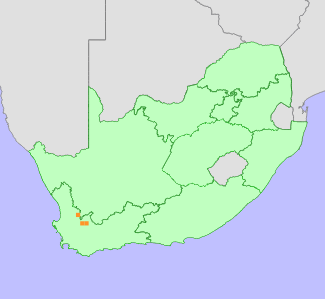|
Scientific Name | Conophytum bicarinatum L.Bolus |
Higher Classification | Dicotyledons |
Family | AIZOACEAE |
National Status |
Status and Criteria | Endangered A3cd |
Assessment Date | 2021/11/09 |
Assessor(s) | A.J. Young, P.G. Desmet, I. Ebrahim, D. Guo, A. Harrower, L. Jabar, L. Knoetze, C. Rodgerson, P.C.V. Van Wyk & N.N. Mhlongo |
Justification | This succulent is endemic to the Western Cape of South Africa with an extent of occurrence (EOO) of 846 km² and area of occupancy (AOO) of 28 km². The dwarf succulents that comprise this genus have been increasingly targeted by illegal collection in recent years and the vast majority of species are in high demand by collectors. Whilst there is no evidence of illegal collection at the time of this submission, closely related species, including some from the immediate area, have been illegally removed from habitat with a dramatic increase in the number of species and volume of plants targeted since 2019. The threat of illegal collection is therefore regarded as very high for some subpopulations of this particular species and a decline of 50% or more of the total population is likely within the next three generations (90 years). Due to its restricted distribution, it is not possible to model climate impacts to this species however, climate models for related species from the same region indicate an average loss of 63% of suitable bio-climatic habitat by 2080 under likely CO2 emission scenarios (RCP 2.6). It therefore qualifies as Endangered under criterion A3. |
Distribution |
Endemism | South African endemic |
Provincial distribution | Western Cape |
Range | This species is endemic to the Western Cape province of South Africa in the Cederberg mountains and at the western edge of the Ceres (Tanqua) Karoo. |
Habitat and Ecology |
Major system | Terrestrial |
Major habitats | Fynbos, Succulent Karoo |
Description | This species is endemic to the Rainshadow Valley Karoo bioregion in the Succulent Karoo biome. It is subject to winter rainfall. The plants typically inhabit weathered sandstone pockets in partial shade. Plants have also, rarely, been observed to occupy exposed shallow grit-filled pans on weathered sandstone. This species has a generation length of 30 years. It is expected to be sensitive to the impacts of climate change as it does not disperse and while adapted to arid conditions, is dependent on limited seasonal rainfall. Species in the genus are sensitive to long periods of drought. Drought related mortality has been observed for other closely related taxa within the genus. |
Threats |
| This species has a very small legal trade in cultivated plants and there are no reports of illegal collection of plants from habitat. However, an extensive illegal trade for the ornamental succulent market in habitat-collected plants of other species within this genus has developed since 2019. This particular species is therefore considered to be at risk of illegal collection in the future and a suspected decline of 50% or more is likely within three generations. The location of the main subpopulation is well known, although the other subpopulations occur in relatively remote sites.
Anthropogenic climate change is a long-term threat to this species. While it is not possible to model the response of this species to climate change due to its restricted distribution, the average loss to climate change for five more widely distributed Conophytum species occurring within the same region is used as an indication of likely impact to this species. Climate models for the likely emission scenarios where emissions stay at present day levels (RCP 2.6) (Hausfather and Peters 2020) and worst case scenarios where emissions continue to increase during the 21st century (RCP 8.5) indicate that there will be a loss of suitable bioclimatic envelope of between 63% and 82% by 2080 for Conophytum taxa within the region. Species in this genus have limited dispersal ability and migration to suitable habitats elsewhere is regarded as highly unlikely. |
Population |
This species is known from three disjunct subpopulations, one of which consists of several hundred plants. The plants are likely to be more widespread than currently known due to the inaccessible nature of some of the potentially suitable habitat. There are probably well in excess of 2,500 individuals. The number of plants in this general area have been in decline in recent years due to an extended drought and the population is believed to be in decline.
|
Population trend | Unknown |
Assessment History |
Taxon assessed |
Status and Criteria |
Citation/Red List version | | Conophytum bicarinatum L.Bolus | Least Concern | Raimondo et al. (2009) | | Conophytum bicarinatum L.Bolus | Lower Risk - Near Threatened | Victor (2002) | | Conophytum bicarinatum L.Bolus | Rare | Hilton-Taylor (1996) | |
Bibliography |
Hammer, S. 2002. Dumpling and his wife: New view of the genus Conophytum. EAE Creative Colour, Norwich.
Hammer, S.A. 1993. The genus Conophytum: A conograph. Succulent Plant Publications, Pretoria.
Hausfather, Z. and Peters, G.P. 2020. Emissions - the 'business as usual' story is misleading. Nature 577(618-620).
|
Citation |
| Young, A.J., Desmet, P.G., Ebrahim, I., Guo, D., Harrower, A., Jabar, L., Knoetze, L., Rodgerson, C., Van Wyk, P.C.V. & Mhlongo, N.N. 2021. Conophytum bicarinatum L.Bolus. National Assessment: Red List of South African Plants version 2024.1. Accessed on 2025/12/02 |
 Comment on this assessment
Comment on this assessment


